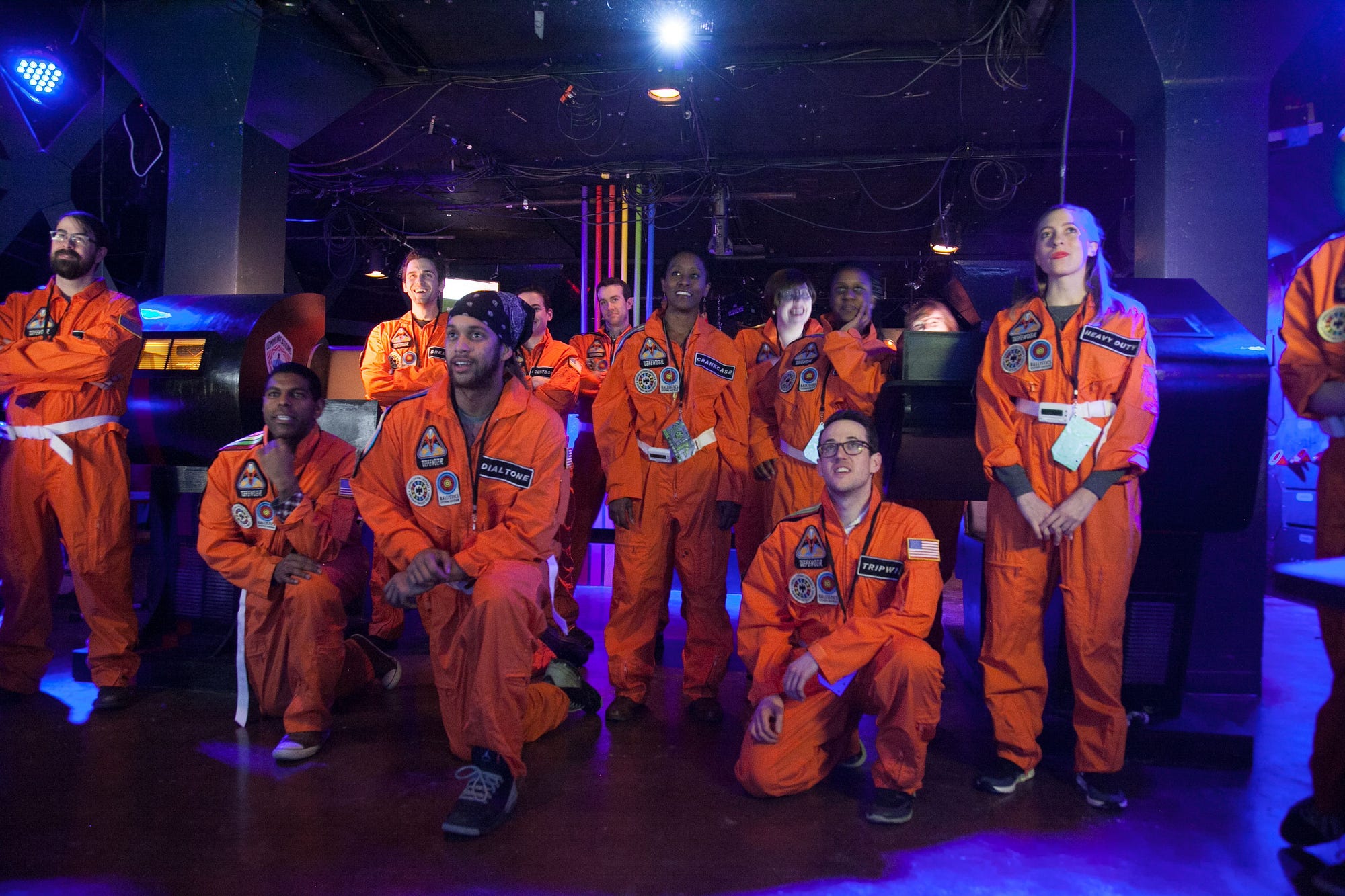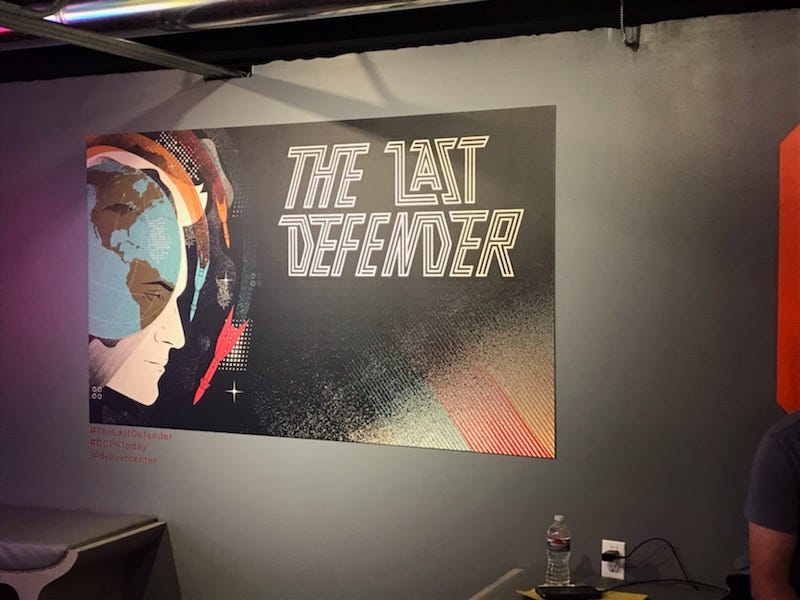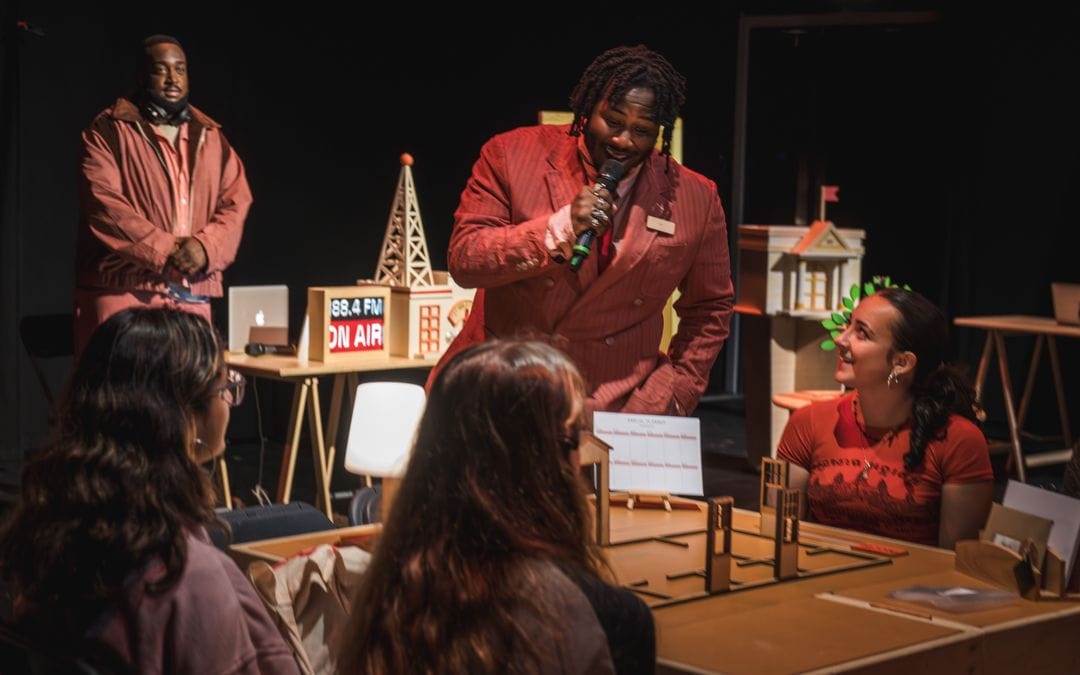
A security guard pushes open a door to a non-descript commercial space tucked between an outfitter store and a sushi restaurant in downtown Denver.
“Last Defender?” she asks.
I nod, and am directed to go down a flight of stairs and to the left. At the bottom of the stairs, I open a door and look to the left, then right. I see some humans in black jumpsuits enter a room — one of many in this hallway — and follow them in.

I check in with the secretary and am given a lanyard with a code name (“Cover Girl”) and told to take a seat. The neon-lit lounge is cozy and comfortable, decorated with 80’s era posters that start to set the scene for the adventure ahead. Before the game can begin, we’re briefed on the basics of safety and gameplay. The rules are similar to those of most escape rooms, but with one notable difference: our game masters are referred to as “Black Rabbits” and while they’ll be in the room with us, they won’t speak to us. We can ask them questions and observe their behaviors for guidance, but we’ll only receive non-verbal clues from them.
After the briefing, me and my fellow defenders (16 of us in total) are led to the locker room next door, each locker labeled with the code names found on our lanyards. Inside the lockers, we find orange jumpsuits and utility belts designed to fit over our civilian clothes. We immediately begin to suit up, store our personal belongings, and take roll. And just like that, the game has begun.
We pile into an elevator and begin the descent to the Last Defender HQ. On the “ride” down, we begin to get acquainted with one another and make small talk with our new teammates, most of us total strangers to one another. When we finally spill out of the elevator, we file into a large carpeted space equipped with sleeping quarters, a break lounge, and even a fitness center. At the heart of it all are four command centers closely resembling arcade game cabinets.
A video begins to play on a large screen at the front of the room and the Black Rabbits sit cross-legged in front of it, watching with the same attentiveness as a three-year-old fixated on their favorite cartoon. Like lost puppy dogs, we look around at each other and slowly start to mimic their behavior and find seats on the floor. The video is well-produced, with perfect vintage effects, and it’s laced with subtle, dry humor. Finally, things start to fall into place as we learn why we’re here and the tasks at hand.
It’s 1983, the United States and The Soviet Union are still mired in the Cold War, and apparently we’re the only ones who can end it.

Suddenly, the video is over. Our large group is broken into smaller teams and we’re solving puzzles at our workstations. The build-up to this moment was easily 20 minutes in the making — an exceptionally long, detailed, and transformative onboarding process that standard escape rooms could take a few notes from. Instead of a game master reciting generic, scripted lines that attempt — but instantly fail — to set the scene, we’re left to see and experience the flip into this other world on our own terms, in our own minds.
It’s worth noting that this event is billed as “part theatre, part puzzle solving, and part live action game.” In reality, I would say that it’s a beautifully designed, well-themed escape room suited for large groups. If there were indeed theatrical and live action elements, they were lost on me.
But that’s not to say The Last Defender isn’t something special.
The realistic, high quality build-out of Defender HQ is a work of art on its own. Everything is stable and sturdy; you’d expect it to be a permanent installation if you didn’t know better. Technology is everywhere in the space and it all works flawlessly. The 8-bit soundtrack reinforces the 80’s time-transport, while humorous Easter eggs are hidden throughout (such as an “Occam’s Razor” station on the engineering panel with a controller that can be set to “Gillette” or “Schick”); they give the entire experience an enjoyable satirical slant.
Get Danielle Riha’s stories in your inbox
Join Medium for free to get updates from this writer.
SubscribeSubscribe
The puzzles come in many varieties and varying skill levels, though the novice escape room player will almost surely struggle. In addition to complex, multi-level puzzles, the experience of playing a non-linear, 16-person game is pure chaos by default. However, more advanced escape room players and puzzle fanatics will potentially view this as the upgrade they’ve been seeking — a room that takes things to the next level.
As we play, I begin to notice mixed reactions to the Black Rabbits and their guidance, which comes mostly in the form of obnoxious, rapid clapping when we do, or suggest doing, the correct things. It’s a bold directorial move, but the novel design of the 16-person game actually requires this dynamic and personalized assistance, placed in-world. No single game master could monitor and aid a group this size via video feeds, nor would anyone be able to hear their instructions piped in through a speaker over the loud sound effects and utter pandemonium of the game.
Are the Black Rabbits amusing? Yes. Helpful? Sometimes. Annoying? Frequently. Other people genuinely enjoy the Rabbits, but wish they would clue less frequently, and some even interpret their petulant praise and guidance as taunting. If the silent Black Rabbits were instead thematic characters who could interact with players in more meaningful ways than pointing and clapping, it would introduce the missing theatrical element to The Last Defender and thus elevate the game to an even deeper level of interactivity and agency.

As we continue to divide and conquer (about a third of the way through the game, we are shocked to discover that ten puzzles have opened up at once), it’s simple enough to find and interpret directions to the next task. Moreover, interstitial videos at crucial points in the game do a nice job of giving context and advancing the story. In real time, though, I feel totally confused about who is being bombed and how what we’re doing at HQ is having any effect on the outside world. This confusion, multiplied by the FOMO of things happening all around me that I do not get to witness firsthand, leaves me feeling anxious and discouraged.
Maybe that’s the fallout of creating a game for a group this size, or perhaps that’s the exact sensation the designers wanted to invoke for this Cold War-themed game. Some of the 10 puzzles were solved very quickly and intuitively, while others had the entire team of 16 Defenders scratching their heads. I tend to think nuking enemies around the world would involve a lot of the same: total chaos, tons of luck and intuition, and bit of strategy.
To this end, just as with the on-boarding process and build-out of the space, the designers of the game have nailed it. These feelings of excitement and confusion, maybe even despair, come from a genuine place inside each player and are what make The Last Defender more than “just” an escape room. The experience is riddled with expertly crafted details, from the moment you step in off the street until you retire your jumpsuit and receive your classified post-mission documentation at the end. The gameplay evokes emotion and intentionally moves players outside of their comfort zone. While it’s pretty unlikely that you will actually manage to save the world in this complex web of challenging puzzles, I’m inclined to think The Last Defender is intended to be more about the journey than the destination, anyways.

My group didn’t get the satisfaction of successfully defending the world from nuclear explosion, nor were we given the solution to the final puzzle that ate up all of our remaining minutes, so I left feeling a bit defeated and sad. But I also felt really good about the one puzzle I did get to solve with my teammate who I’d never met before that day. Are these feelings designed to be parallels to the storyline? Metaphors meant to make us ponder war and its effects on the human psyche? I can’t say for sure, but I do know The Last Defender should be filed under “medium to hard” and not recommended for first-time players in the world of immersive arts.
If you and your buddies are ready to put your puzzle-solving minds into overdrive, and down to make some new friends along the way, then sign up to play The Last Defender before it’s gone at the end of its run on July 28.
The Last Defender continues through July 28. Tickets are $25.
Read our interview with the creators.
NoPro is a labor of love made possible by our generous Patreon backers. Join them today!
In addition to the No Proscenium web site, our podcast, and our newsletters, you can find NoPro on Twitter, Facebook, YouTube, Instagram, in the Facebook community Everything Immersive, and on our Slack forum.
Office facilities provided by Thymele Arts, in Los Angeles, CA.




















Discussion